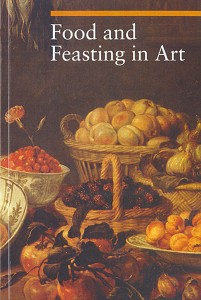Food and Feasting In Art
Art historian
Silvia Malaguzzi has an appetite for paintings that contain representations
of food and drink. In her book FOOD AND FEASTING IN ART, published by
J. Paul Getty Museum, she explains why she seeks out these paintings and
draws so much knowledge and satisfaction from them. Displaying an impressive
erudition, she begins her 384-page guide to the visual vocabulary of Western
art by discussing a dozen-odd illustrations of episodes from the Old and
New Testament--Rubens' Adam and Eve, Tintoretto's Belshazzar's Feast,
Bosch's The Marriage at Cana, among others.

Regarding the latter, she comments: "The wedding feast is the setting
for Christ's miraculous transformation of water into wine." After
identifying the cupbearer who offers the miraculous wine to the bride,
Malaguzzi's keen eye picks out details that give even deeper meaning to
the painting. "Among the vessels on the sideboard at the rear is
one shaped like a pelican, a bird that was a traditional symbol of Christ...The
pig's head is a symbol of sin....The swan is also a symbol of Venus, goddess
of love. In one of Bosch's many otherworldly touches, the swan spouts
fire, possibly a reference to the myth that the swan sings when it is
about to die."
In her section on The Places and Rituals of Dining, Malaguzzi comments on paintings of Markets, Shops, Kitchens, Dining Rooms and Banquet halls, Refectories, Cafes, Taverns and Restaurants. About the latter, she says: "In restaurants, private and public mingle in a modern form of exchange. They were a favorite setting for the cross sections of urban society so beloved by 19th-century painters...but their images could also be used to convey the isolation of the individual in society."
The largest section of her book investigates the symbolic meanings of individual foods and drinks. Did you know, for example, that the shreds of lettuce in Rembrandt's The Supper at Emmaus are a symbol of penitence? "Placed here beside the lamb, a symbol of Christ, it represents the contrition necessary to wash away the crime of killing Christ."
There are fascinating--and often humorous--tidbits like that on every page of FOOD AND FEASTING IN ART, which also contains 400 splendid color illustrations. The latest volume in the Getty's Guide to Imagery series is available at bookstores or by calling 800-223-3431.
